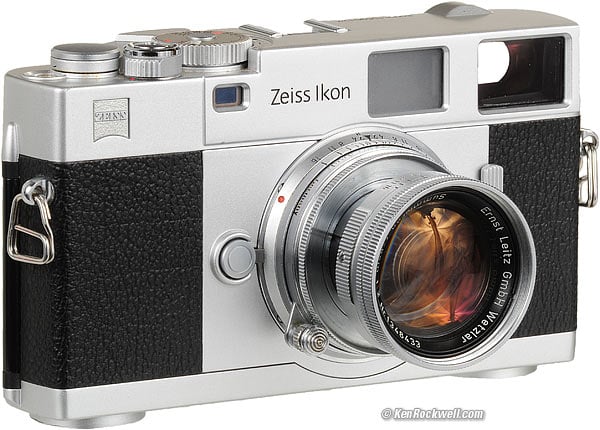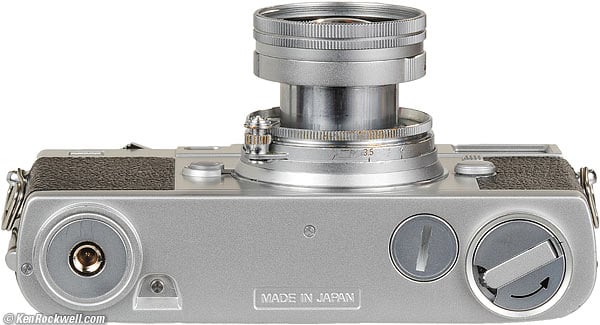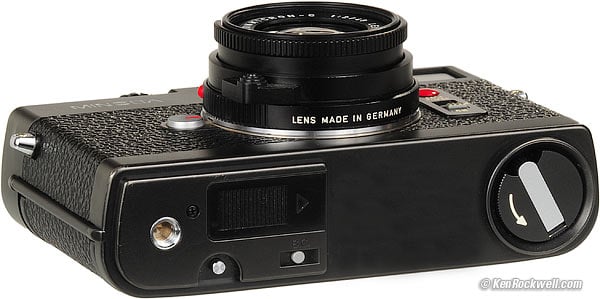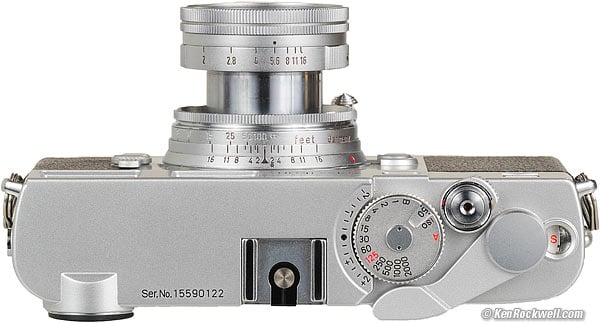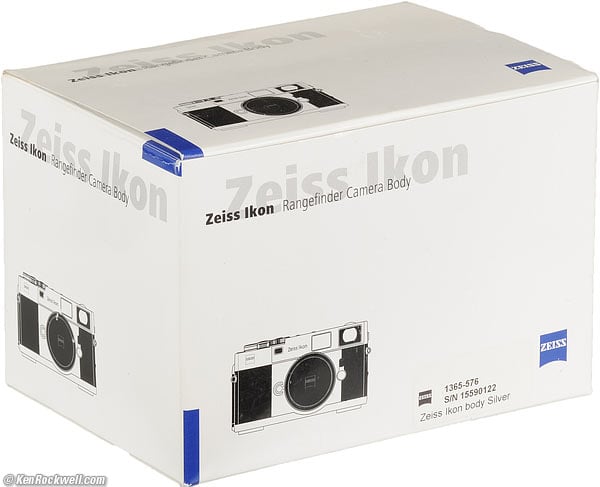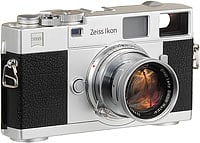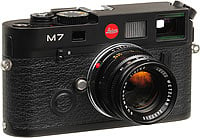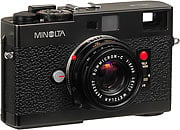Home Donate New Search Gallery How-To Books Links Workshops About Contact
Zeiss Ikon
(2005-)
© 2009 KenRockwell.com. All rights reserved.
Intro Specs Performance Usage Compared Recommendations
Zeiss Ikon in silver (modern) and Leica collapsible 5cm f/2 Summicron (1954). (16.790oz/476.0g with film and batteries but no lens.) enlarge. I'd get it at Adorama (all four versions) and Amazon in silver or black. It helps me keep adding to this site when you get yours through these links, thanks! Ken.
June 2009 More Leica Reviews Shooting the Zeiss Ikon Digitally
Strengths: Replacement for the Leica M7 with a better viewfinder, better dependability, faster film loading, better meter and better ergonomics.
Weaknesses: No 135mm frame lines. On/off switch can trick you into missing shots, so leave it ON all the time. Louder, clankier shutter than Leica.
Introduction top
Intro Specs Performance Usage Compared Recommendations
Versions Voigtländer Minolta CLE Compatibility
|
I personally buy from Adorama, Amazon, Ritz, B&H, Calumet and J&R. I can't vouch for ads below.
|
The Zeiss Ikon is a Leica M-mount rangefinder camera that is much nicer than I expected. It uses every Leica lens made for the M cameras since 1954, as well as Zeiss and Voigtländer lenses made for Leica.
The Zeiss Ikon is a wonderfully easy-to-use camera. Its English user's manual is only 24 pages, and if you already know how to load and shoot any other film camera, you can skip it.
The Zeiss Ikon is a replacement for the Leica M7, both of which are manual-focus electronic 35mm cameras.
Here's 99% of my review: The Zeiss Ikon works and feels better than a Leica M7 for actual shooting, while the Leica M7 feels better for holding in your hand and showing around to your friends. They both do the same thing.
For actual photography, I find plenty of advantages to the Zeiss over the Leica.
The Leica M7 costs over three times as much, weighs over 30% more and takes twice as many tougher-to-find batteries, but the Leica does feel nicer to play with. The Leica M7 and might be more likely to have parts available 50 years from today, but for actual photography, the Zeiss Ikon is a better camera.
The only tangible things at which the Leica M7 beats the Zeiss Ikon are long exposure times, extreme low-light metering and TTL flash. The Zeiss may not have TTL flash, but it does have a 1/125 sync which actually lets you use flash compared to Leica's silly 1/50 sync. The Zeiss stops at 8 seconds, which is more than enough for most people, while the M7 goes to 38 seconds in Auto, and clocks bulb exposures with an LED timer out to 16 minutes.
Both the Zeiss and Leica M7 have TTL metering for regular exposures, and both have metered manual modes.
The Zeiss Ikon has a clearer finder than the Leica M7. The M7's finder is often littered with finder lines for other lenses, while the finder of the Zeiss Ikon usually shows only the lines you need. The Zeiss finder tells you what lines correlate to which lens, while you have to guess with the Leica.
The Zeiss Ikon's viewfinder is 5mm further away from the lens, so there is much less finder cutoff with the LEICA 28mm f/2 SUMMICRON-M ASPH and LEICA 35mm f/1.4 SUMMILUX-M ASPH than on the M7.
The finder of the Zeiss Ikon allows you to put straight lines in the subject on top of the frame lines in the finder, while the Leica M7 often distorts the subject as seen through the finder so that lines on the subject curve and cannot be placed on the straight lines of the finder frame lines.
The Zeiss Ikon has a big eyepiece so you can see the entire 28mm frame, while the tiny rectangular hole in the eyepiece of the M7 0.72 makes the 28mm frame hard to see.
The rangefinder spot of the Zeiss Ikon is always clear and visible, while many Leica M7s flare easily, requiring me to have to move my eye around to focus.
The Leica shoots with a dull click, while the Zeiss isn't much louder as a sharper, more metallic click. (The Leica shutter is cloth, while the Zeiss is metal.)
The Leica is a pain to load, while the Zeiss is a breeze. The Zeiss has a window to show you what film is loaded, while the Leica has nothing.
The Zeiss Ikon allows direct locking adjustment of film speed, while the M7 offers no lock and a kludgy at best arrangement for setting film speed. My Leica M7 has been horribly unreliable in setting film speed, while the Zeiss Ikon I borrowed worked like every other camera.
The Zeiss Ikon makes it easy to set exposure compensation without taking your eye from the finder, while the M7 makes you take the camera away from your eye and screw with interlocks.
The M7 magically locks exposure with the shutter halfway down, while the Zeiss Ikon has a dedicated AEL button you can hit with your eye on the finder. Once locked, the Zeiss Ikon stays locked for as many exposures as you like, while you'd have to go into Manual with the M7 to do the same.
The meter pattern of the Zeiss Ikon is a perfect center-weighted pattern, while the M7 meters only from a limited central area which often requires you to meter from one area and recompose using the M7's always-present AE lock.
The meter of the Zeiss Ikon works normally, while the meter of the M7 goes bananas if you point it at anything that flickers like a computer or TV monitor. (The M7's meter's time constant is way too fast — a design flaw — so its readings flicker all over the place if you point it at most TVs.)
Versions top
The Zeiss Ikon comes in four versions: your choice of silver or black, and with or without the viewfinder and rangefinder.
Black and white are the same price. The usual version shown here sells for about $1,410, and the version without the finder sells for about $925 in the USA as of June 2009.
All versions have TTL metering.
The finderless versions have three external LEDs to show the general shutter speed range in Auto, or delta in manual exposure.
Zeiss calls the finderless versions "Superwide," since you use external finders for superwide lenses anyway. I'd get the regular version, since all Leica and Zeiss superwide lenses couple to the rangefinder for focus, even if you need external finders for 21mm, 18mm and 15mm lenses to cover the wider angles.
What about Voigtländer? top
I like this Zeiss Ikon, but I've not been excited by any of the Voigtländers I've used.
Yes, both Voigtländer and Zeiss are made by Cosina, but they are completely different cameras.
There is no joy in using the Voigtländers. The Voigtländers are practical, but not that much fun to use.
The Voigtländers require you to select the framelines manually every time you change lenses, while the Zeiss, Minolta and Leicas do this automatically.
The Voigtländers have skimpy viewfinder base lengths, making them sketchy for use with anything longer than a 50mm lens, while the long-base rangefinders of the Leica and Zeiss Icon make using 90mm lenses a breeze. Even the Minolta CLE has a wider rangefinder base than the Voigtländers.
What about the Minolta CLE? top
Minolta stopped making CLEs in 1985. The CLE lacks AE lock and many finder framelines, but also otherwise replaces the Leica M7. The CLE and M7 have TTL flash, if you care, which the Zeiss doesn't.
The CLE is smaller and lighter, and has a shorter rangefinder base length than the Leica or Zeiss.
Zeiss pays homage to the CLE's strong Leica heritage by copying the CLE's C-shaped body cross-section and rewind crank! I'm serious: compare the bottoms of the Zeiss and the CLE and you'll see they have the identical shape and rewind crank. The only difference is that Zeiss has a separate back release button, while the CLE integrated it into the rewind crank.
See also Leica M7 compared to the Zeiss Ikon and Minolta CLE.
Bottom, Zeiss Ikon and 50mm f/2 Summicron. enlarge. enlarge.
Bottom, Minolta CLE and 40mm f/2 Summicron. enlarge.
Compatibility top
The Zeiss Ikon is compatible with the Leica system. In fact, it works better, with less finder cut-off with some lenses, like the superb Leica 28mm f/2 ASPH than Leica's own cameras because the Zeiss finder is further away from the lens!
I use the Zeiss Ikon with my Leica M lenses from 12mm to 90mm exactly as I use them with my Leica M3, M4-P and M7. Focus, metering and everything works great, in fact, often better than on the LEICA.
Use the Zeiss Ikon with your Leica lenses, and if you have them, Zeiss, Voigtländer, Konica and whatever other Leica M-mount lenses you please.
The Zeiss Ikon's finder covers 28mm, 35mm, 50mm and 85mm. As usual, slide ultrawide finders into the shoe.
I found no problem using the 85mm lines for my 90mm lenses. The Zeiss Ikon lacks frame lines for 135mm and 75mm lenses.
I had no problem with collapsible lenses or a 1950's 21mm f/4 Super-Angulon which pokes deeply into the camera.
Incompatibilities
Forget 75mm and 135mm lenses. There are no framelines for them.
You can use Leica lenses with eyes for the M3! You're pushing it because the Zeiss' finder isn't really in the same place to look through the eyes properly, but for 35mm lenses, it's not fun, but the results are fine.
If you use a 35mm lens for the M3, the finder shutter speed display lands outside the oculars on clear area outside of the Ikon's 50mm frame.
Be careful with 90mm lenses. On all rangefinder cameras there often are incompatibilities leading to incorrect focus. Select your 90mm lens with care to be sure it matches well to your sample of camera.
Top, Zeiss Ikon, with Leica collapsible 5cm Summicron from 1954. enlarge.
Specifications with commentary top
Intro Specs Performance Usage Compared Recommendations
Type top
35mm rangefinder, Leica M bayonet mount lenses, electronic vertical metal focal-plane shutter camera.
Color top
Silver as shown, or all black.
Lenses top
Leica M bayonet, unchanged since 1954.
Doesn't care about 6-bit coding.
Finder top
0.74x.
Frame lines for 28mm, 35mm, 50mm and 85mm.
28mm and 85mm show together, while 35mm and 50mm appear by themselves.
Shutter speeds are shown as red numbers along the left side of the finder. They appear between the positions of the 28mm and 35mm frame lines.
75mm base length x 0.74x = 55.5mm effective base length, same as Leica 0.72 finders ± 12% (Leica 0.72 is 49.86mm, the same for practical use).
Finder Displays top
A row of red numbers light up along the left side of the finder.
Out of range is shown by blinking.
Only one lights at a time, so half stops can't be displayed as they can on the Minolta CLE or Leica M7.
Close Focus Range top
The Zeiss Ikon rangefinder couples as close as 2.3 feet (0.7 meters), lens permitting.
Metering top
The Zeiss Ikon meters light reflected from a gray bar on the shutter blades.
It only meters when the film is wound, just like the Leicas. (The Minolta CLE meters even with the film isn't wound.)
AE Lock top
Press the button under the hot shoe. AE lock holds until you cancel it so you can shoot multiple shots.
Auto Meter Range top
The Zeiss Ikon meters from 8 seconds to 1/2,000 at most ASA settings.
It only displays down to 1, even if the exposure is between 1 and 8 seconds.
If the exposure needs to be longer, the 1 blinks.
ASA Range top
ASA 25 ~ 3,200.
100 and 400 are in red.
Film-Type Reminder top
There is a hole in the back to let you see the film cartridge.
Cable Release top
Standard $6 screw-in.
Self Timer top
No.
Shutter top
Electronic, vertical metal focal-plane.
8s - 1/2,000 in 1/12-stop steps in Auto mode.
1 - 1/2,000 in manual mode.
You can't cheat in auto; all you get is 8 seconds maximum.
Flash Sync top
1/125.
Flash Hot Shoe top
Yes.
There are no extra contacts, so feel free to use any other brand flash.
Power top
Two very common S76, A76 or LR44 button cells.
You can find these everywhere, and if you can't find them alone, you will find them in many kid's noisy electronic toys, books and keychain laser pointers.
I buy these A76/LR44 cells wholesale for 21¢ each. It's trivial to keep spares in your wallet.
Size top
5.4 x 3.1 x 1.3 inches, WHD.
138 x 78 x 32 mm, WHD.
Weight top
I measure 16.010 oz. (453.8g) with batteries and strap lugs, but no lens, no strap, no film and no case.
With film, I measure 16.790 oz. (476.0 g).
Price top
USA, July 2010: $1,620 for the regular Zeiss Ikon, or $925 for the version without the finder.
USA, 6/09: $1,410 for the regular Zeiss Ikon, or $925 for the version without the finder.
Box, Zeiss Ikon. enlarge.
Performance top
Intro Specs Performance Usage Compared Recommendations
Ergonomics top
Ergonomics are just about perfect. I easily can shoot one-handed. Film loading is 3.7 times as fast as with the LEICA.
Exposure compensation is easy: just tweak the dial. The 0 position is detented a little more heavily.
Film winding is very fast.
I can rewind a roll of film in 8 seconds by hand, but the crank turns backwards. It's weird, but works fine.
The lock lever which surrounds the shutter release can fake you out. Red means GO, but if you have it locked (no dot visible), you still can press the shutter but nothing happens.
If you're me, this can have you checking batteries, film winding and other things, not realizing that the unmarked switch got turned to OFF (I always leave mine ON). On the Leica M7, the same switch in the same place locks the shutter button, so you know even before taking the picture that you're locked, while the shutter button of the Zeiss Ikon feels the same regardless of the shutter lock's position.
The shutter dial edge is sharper and less comfortable than the Leica M7's.
The Zeiss Ikon's shutter speed dial rotates 360,º just like the Leica M7.
The Zeiss Ikon's lens release button is superior to the Leica M7. I can use the Zeiss Ikon's lens release button, while the Leica M7's button is hidden behind a guard.
The frame counter is big and easy to read in soft light, but hard to read in hard light. It is marked to frame 37 even though you can shoot further.
Metering and Exposure top
The center-weighted TTL meter works great.
It compensates for any errors in filters or diaphragm calibration.
I prefer the Zeiss Ikon's broad center-weighted pattern to Leica's tight and unmarked center-only pattern, since the Leica's meter often forces me to have to pre-meter and re-compose.
With the Zeiss Ikon, I just shoot and rarely need AEL, preferring to use compensation as needed.
Manual metering is slower and less precise than LEICA. Leica provides three > o < LEDs which lets you set perfect manual exposure instantly. The Zeiss Ikon merely blinks the speed LED it wants you to set, and the LED for the speed at which you are set stays solid. You have to chase the blinking LED, and the primitive Zeiss' LED system allows for errors of up to a half stop.
The Zeiss Superwide is better, with three LEDs for manual, but worse for Auto, with the same three LEDs.
Finder top
The finder is much cleaner than Leica's finders because it's not cluttered with frame lines for lenses you'll never use. I've covered a lot of other ways that the Zeiss outperforms the Leica above.
The frame lines are always clear, and each is marked in millimeters.
The finder window is further away from the lens than on Leicas, so there is less cutoff with 28mm lenses, like the older f/2.8s and today's state-of-the-art 28mm f/2 ASPH.
The 85mm frame is four small corners, rather than a frame. It works fine for 90mm lenses.
The view through the finder is somewhat polarized. Pay attention if you're looking to see the effects of polarizing filters.
The red meter numbers are easy to read in most conditions other than bright sunlight, in which case they aren't as bright as they should be.
Focus top
The rangefinder spot is always bright, clear and contrasty. It has none of the flare common in many recent Leicas.
Rangefinders drift with time and use. You always need to have your serviceman keep up on keeping your rangefinder well adjusted, just like you needed to get tune-ups every 3,000 miles on 1950s cars or they'd stop running.
Only about half of my 90mm lenses couple well with any given LEICA body. Just as with LEICA, you'll need to hand-pick your 90mm lens to give perfect focus at full aperture. Sorry, that's the way all rangefinder cameras are with long lenses.
Mechanics top
The Zeiss is made in Japan.
The top and bottom covers are cast light metal, not heavy brass like Leica.
Thus the Zeiss Ikon weighs over 30% less (16.790oz/476.0g versus 22.265oz/631.2g as measured in my laboratory) and feels dinkier than the LEICA.
The LEICA feels like a brick, while the Zeiss feels weak in direct comparison.
The LEICA feels great for handing your neighbor to impress him with your value as a man, but feels a lot worse around your neck for a week.
The Leica discretely engraves its serial number into the hot shoe, while the Zeiss Ikon loudly engraves it in an opposite color in big numbers on the top cover; one more thing to black out before heading into the field.
The rangefinder frameline illumination window of the Zeiss is coated ground glass, while Leica has only used plastic since 1964.
Almost everything is metal on the Zeiss, including the finder preview lever tip, wind lever tip, finder eyepiece surround and battery cover, all of which are plastic on the LEICA.
Sound and Noise top
The Zeiss Ikon isn't quite as quiet as the Leica M7.
The Zeiss makes more metallic click, while the Leicas make more of a soft clunk.
Trigger Pull (Shutter Release) top
The trigger pull is short and stepped, compared to the Leica's longer pull with even more delineations.
The LEICA has a separate step for AEL, while the Zeiss has just a meter ON step and then fire after that.
Frame Counter top
The frame counter is big, but hard to read in contrasty light. I prefer the Leica counter which is as easy to read in any light.
The Zeiss' odd frames are numbered.
Frames S, 24 and 36 are in orange.
The frame counter stops advancing at the 37 mark, while film keeps shooting until you run out.
Film Economy top
I get 39 good exposures on every roll, just like on Leica.
How? Simple: I shoot frame zero, and keep going until the end.
The Zeiss Ikon is so small that you don't waste any film loading or winding.
Power top
Two silver (EPX-76 or S76) or alkaline (A76) cells are fine. I buy these A76/LR44 cells wholesale for 21¢ each. A DL1/3N lithium cell is also perfect.
You can get the 76 cells anywhere, and if you get stuck, drop into any Wal-Mart or dollar store and you'll find loads of silly toys and lights that use three of these cells, batteries included, for 99¢.
I've never shot this enough to run down a set; however a heavy user shares that he gets about 50 36-exposure rolls per set.
Measured power drain and computed battery life:
OFF: 0 uA.
ON (idle): 5 uA (3 years)
Film not wound, no meter, but shutter held down: 50 uA (4 months).
Meter ON: 7-10 mA (15 hours).
Shutter open: 15mA (8 hours).
Zeiss doesn't specify battery life. If I compute that for each frame you'll look at the meter for 8 seconds (probably less) and make a two 4-second time exposures on each roll, that calculates to (8s x 39 frames x 8mA metering) + (10s x 15mA open shutter) = 2,496mAs + 150 mAs = 2,646 mAs per roll.
Since A76 cells are good for 130mAh, or 468,000 mAs, 480,000/2,646 = about 180 rolls of film per 42¢ pair of A76 cells. Don't come complaining to me if you can't afford batteries; get a mechanical Kodak Retina IIIc or Olympus Trip 35 with selenium meters if you want to shoot without batteries.
Usage top
Intro Specs Performance Usage Compared Recommendations
Rear, Ziess Ikon. enlarge.
The Zeiss Ikon is easy to load and shoot.
All you have to do is slide the back release forward and up to open the back. Pull out the crank to pop in the film. The red dot around the shutter release is ON, and low battery is indicated by the 2000 and 1 blinking in the finder.
Set the ISO on the shutter dial. It locks and works as God intended. It's not a flakey putrescence like the LEICA's ISO setting.
Speeds are shown in the finder from 1 to 1/2,000. Speeds from 1 to 8 seconds light the 1, and if the meter thinks you need more than the 8 second maximum, the 1 blinks. If you need a speed faster than 1/2,000, it blinks.
Just like the Leica M7, the Zeiss Ikon's exposure compensation dial runs backwards. Be careful.
For AE lock, press the button below the hot shoe. AEL blinking in the finder and holds your setting until you press AEL again, or the camera goes to sleep.
AE lock locks the shutter speed. If you change the aperture, you change your exposure because only the the shutter speed remains unchanged.
The rewind button is normal, but the rewind crank is on the bottom and spins backwards.
Have fun!
Compared to the M7 and CLE top
Intro Specs Performance Usage Compared Recommendations
Zeiss Ikon |
See Leica M7 compared to the Zeiss Ikon and Minolta CLE.
Recommendations top
Intro Specs Performance Usage Compared Recommendations
Among the Leica M7, Zeiss Ikon, Minolta CLE and the Voigtländers, I'd opt for this Zeiss for practical daily shooting, the LEICA for long time exposures, or the Minolta CLE for absolute least weight.
I'd skip the Voigtländers
I'd use the Leica Strap to tote any of these cameras.
PLUG
I support my growing family through this website.
If you find this as helpful as a book you might have had to buy or a workshop you may have had to take, feel free to help me continue helping everyone.
If you've gotten your gear through one of my links or helped otherwise, you're family. It's great people like you who allow me to keep adding to this site full-time. Thanks!
If you haven't helped yet, please do, and consider helping me with a gift of $5.00.
The biggest help is when you use any of these links when you get anything. It costs you nothing, and is this site's, and thus my family's, biggest source of support. These places always have the best prices and service, which is why I've used them since before this website existed. I recommend them all personally.
Thanks for reading!
Ken
Home Donate New Search Gallery How-To Books Links Workshops About Contact

